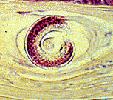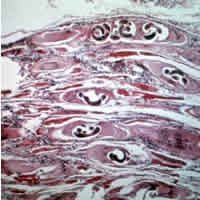Difference between revisions of "Trichinella"
| (17 intermediate revisions by 3 users not shown) | |||
| Line 1: | Line 1: | ||
| − | + | [[Image:Trichinella spiralis H and E.jpg|thumb|right|200px|''Trichinella spiralis'' stained with H and E - Courtesy of the Laboratory of Parasitology, University of Pennsylvania School of Veterinary Medicine]] | |
| − | + | [[File:Trichinella larvaeD.jpg|thumb|200px|right|''Trichinella'' in tissues. Wikimedia commons.]] | |
| − | |||
| − | |||
| − | |||
| − | [[File:Trichinella larvaeD.jpg|thumb|200px|right|''Trichinella'' in tissues. | ||
| − | |||
| − | + | ==Overview== | |
| + | *This is known as the "worm that thinks its a virus" | ||
| + | *It is an important zoonosis | ||
| + | *It is covered in greater detail | ||
| − | + | *''Trichinella'' in [[Parasitic Myositis#Nematodes|myositis]] | |
| − | + | == Trichinosis == | |
| + | ''Trichinella'' is a serious public health hazard and could occur at any time in the UK. | ||
| − | |||
| − | |||
| − | |||
| − | + | === '''''TRICHINELLA SPIRALIS''''' === | |
| + | *This is very rare in British pigs, if it occurs at all. | ||
| + | *Free-range pigs are at greatest risk of becoming infected. | ||
| + | *Infections are asymptomatic in the pig. | ||
| + | *It is an important zoonosis, with 6500 human cases in the EU between 1966 and 2001. | ||
| + | *Human disease is serious and sometimes fatal, with myositis, myocarditis, encephalitis and facial oedema. | ||
| + | *Human cases are most often, but not invariably, associated with pigs. | ||
| + | *Other meat animals can also be the source of human infection, e.g. horses in France and Italy, wild boar in Eastern Europe, bears in North America, walruses in the Arcitc. | ||
| + | *The last human trichinosis epidemic in Britain occurred some 50years ago. | ||
| − | + | ==== Life-Cycle ==== | |
| + | Encysted larvae are eaten by an animal. The adult worm develops, and then enters the small intestine. The larve migrate through the blood, via the lymphatics, to striated muscle, where the larvae develop to the infective stage. | ||
| − | + | *''T. spiralis'' can infect a wide variety of mammals. | |
| − | + | *The adults are only approximately 3mm long, and are closely applied to the mucosa of the small intestine. | |
| + | *The life-cycle is unique in two respects: | ||
| + | **it uses the '''same individual''' firstly as the '''final''', and then '''intermediate host''' | ||
| + | **the larvae are ''' intracellular'''. | ||
| − | == | + | ==== Epidemiology of Trichinosis ==== |
| − | ''' | + | There are several species of ''Trichinella'', each with a different host range and slightly different biological characteristics. There are domestic and sylvatic cycles. ''T. spiralis'' is the species that most often affects pigs and humans. |
| − | + | *In '''sylvatic cycles''': | |
| + | **the infection is transmitted within some wildlife populations (e.g. rats) and ascends food-chains to the top carnivores and omnivores (e.g. the fox in Europe) | ||
| + | **carnivores and omnivores are particularly vulnerable, but herbivores can be infected if they accidentally ingest meat (e.g. remains of dead mouse in hay). | ||
| + | **other ''Trichinella'' species occur in wildlife. For example, one infects arctic marine mammals and polar bears (and is highly infective for humans), while another is restricted to some East African fauna (and does not infect humans). A new species has recently been discovered in crocodiles. | ||
| − | + | *In the '''domestic cycle''': | |
| − | + | **the main source of infection for pigs is undercooked swill containing kitchen waste | |
| + | **humans are most often infected by eating undercooked pork or pork products | ||
| + | **one pig is eaten by more than 1000 people, which can therefore lead to mini-epidemics (common source outbreaks) | ||
| + | **recent outbreaks in France and Italy have been traced to meat from horses fed offal-based diets before importation from Eastern Europe. | ||
| − | + | ==== Control ==== | |
| + | The main principles of control are: | ||
| − | + | 1) Pigs must not be allowed to scavenge | |
| − | + | 2) Meat inspection: | |
| − | |||
| − | + | a. Destruction of infected carcasses protects human health and reduces the risk of contaminated swill being fed to pigs | |
| + | b. Detection methods include microscopic examination of diaphragm muscle (trichinoscope); pepsin digestion of diaphragm muscle; ELISA on blood - used mostly for epidemiological surveys | ||
| − | + | 3) Boil swill adequately (compulsory in the UK) | |
| − | |||
| − | |||
| + | 4) Pork products must be well cooked or otherwise treated before human consumption. | ||
| − | |||
| − | |||
| − | |||
| − | |||
| − | |||
| − | |||
| − | |||
| − | + | **Particularly in pigs and dogs | |
| − | | | + | **Public health and economic importance |
| − | + | **''T. spiralis'' affecting dogs, pigs, cats and humans is most common in hotter climates | |
| + | **Larvae distend myofibres | ||
| + | **May be seen grossly if dead and calcified | ||
| + | **Predilection for active muscles, ''e.g.'' diaphragm, intercostal, masseter and tongue muscles | ||
| + | **Histologically: | ||
| + | ***Focal myositis - [[Neutrophils|neutrophils]], lymphocytes, eosinophils | ||
| − | |||
[[Category:Trichinelloidea]] | [[Category:Trichinelloidea]] | ||
| − | + | [[Category:Pig_Nematodes]][[Category:Zoonoses]] | |
| − | [[Category:Pig_Nematodes]][[Category:Zoonoses | + | [[Category:To_Do_-_Steph]] |
| − | [[Category: | ||
Revision as of 16:43, 8 June 2011
Overview
- This is known as the "worm that thinks its a virus"
- It is an important zoonosis
- It is covered in greater detail
- Trichinella in myositis
Trichinosis
Trichinella is a serious public health hazard and could occur at any time in the UK.
TRICHINELLA SPIRALIS
- This is very rare in British pigs, if it occurs at all.
- Free-range pigs are at greatest risk of becoming infected.
- Infections are asymptomatic in the pig.
- It is an important zoonosis, with 6500 human cases in the EU between 1966 and 2001.
- Human disease is serious and sometimes fatal, with myositis, myocarditis, encephalitis and facial oedema.
- Human cases are most often, but not invariably, associated with pigs.
- Other meat animals can also be the source of human infection, e.g. horses in France and Italy, wild boar in Eastern Europe, bears in North America, walruses in the Arcitc.
- The last human trichinosis epidemic in Britain occurred some 50years ago.
Life-Cycle
Encysted larvae are eaten by an animal. The adult worm develops, and then enters the small intestine. The larve migrate through the blood, via the lymphatics, to striated muscle, where the larvae develop to the infective stage.
- T. spiralis can infect a wide variety of mammals.
- The adults are only approximately 3mm long, and are closely applied to the mucosa of the small intestine.
- The life-cycle is unique in two respects:
- it uses the same individual firstly as the final, and then intermediate host
- the larvae are intracellular.
Epidemiology of Trichinosis
There are several species of Trichinella, each with a different host range and slightly different biological characteristics. There are domestic and sylvatic cycles. T. spiralis is the species that most often affects pigs and humans.
- In sylvatic cycles:
- the infection is transmitted within some wildlife populations (e.g. rats) and ascends food-chains to the top carnivores and omnivores (e.g. the fox in Europe)
- carnivores and omnivores are particularly vulnerable, but herbivores can be infected if they accidentally ingest meat (e.g. remains of dead mouse in hay).
- other Trichinella species occur in wildlife. For example, one infects arctic marine mammals and polar bears (and is highly infective for humans), while another is restricted to some East African fauna (and does not infect humans). A new species has recently been discovered in crocodiles.
- In the domestic cycle:
- the main source of infection for pigs is undercooked swill containing kitchen waste
- humans are most often infected by eating undercooked pork or pork products
- one pig is eaten by more than 1000 people, which can therefore lead to mini-epidemics (common source outbreaks)
- recent outbreaks in France and Italy have been traced to meat from horses fed offal-based diets before importation from Eastern Europe.
Control
The main principles of control are:
1) Pigs must not be allowed to scavenge
2) Meat inspection:
a. Destruction of infected carcasses protects human health and reduces the risk of contaminated swill being fed to pigs
b. Detection methods include microscopic examination of diaphragm muscle (trichinoscope); pepsin digestion of diaphragm muscle; ELISA on blood - used mostly for epidemiological surveys
3) Boil swill adequately (compulsory in the UK)
4) Pork products must be well cooked or otherwise treated before human consumption.
- Particularly in pigs and dogs
- Public health and economic importance
- T. spiralis affecting dogs, pigs, cats and humans is most common in hotter climates
- Larvae distend myofibres
- May be seen grossly if dead and calcified
- Predilection for active muscles, e.g. diaphragm, intercostal, masseter and tongue muscles
- Histologically:
- Focal myositis - neutrophils, lymphocytes, eosinophils

